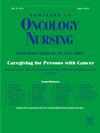癌症儿童疲劳量表:系统评价及信度概化元分析。
IF 2.3
4区 医学
Q1 NURSING
引用次数: 0
摘要
目的:本研究旨在评估疲劳量表的整体可靠性,疲劳量表是评估儿科肿瘤患者疲劳严重程度的最广泛使用的工具,并确定影响可靠性估计幅度的因素。方法:系统检索PubMed、CINAHL、PsycINFO、Medline、Scopus、Embase、谷歌Scholar。从最初确定的492篇文章中,选择了21篇进行最终分析。采用从个别研究中提取的Cronbach's alpha进行信度概化荟萃分析。采用随机效应模型进行分析。结果:大多数研究采用横断面设计来评估患有各种类型癌症的儿童和青少年的疲劳症状。总样本的平均加权效应大小(n = 3,750)为0.915 (95% CI = [0.888,0.934])。在父母样本中,白血病/淋巴瘤的诊断是显著的调节因子(效应估计 = 0.003,P < 0.01),而使用非英语的语言显著调节了父母样本(效应估计 = 0.301,P < 0.01)和工作人员样本(效应估计 = -0.306,P < 0.01)的可靠性。结论:疲劳量表是评估不同儿科肿瘤人群疲劳症状的高度可靠的工具。然而,量表的可靠性可能受到儿童白血病/淋巴瘤诊断和家长和工作人员使用时的语言翻译的影响,在比较和解释结果时需要仔细考虑。对护理实践的启示:疲劳量表是一个可靠的工具,对指导临床护士和研究人员至关重要。他们可以采用该量表来评估旨在缓解儿科肿瘤患者疲劳的干预效果。本文章由计算机程序翻译,如有差异,请以英文原文为准。
Fatigue Scale for Children With Cancer: A Systematic Review and Reliability Generalization Meta-analysis
Objectives
This study aimed to evaluate the overall reliability of the Fatigue Scale, the most widely used instrument for assessing fatigue severity in paediatric oncology patients, and to identify factors influencing the magnitude of reliability estimates.
Methods
PubMed, CINAHL, PsycINFO, Medline, Scopus, Embase, and Google Scholar were systematically searched. From an initial 492 articles identified, 21 were selected for the final analysis. Reliability generalization meta-analyses were performed using Cronbach's alpha extracted from individual studies. A random-effects model was applied for the analysis.
Results
Most studies employed a cross-sectional design to assess fatigue symptoms in children and adolescents with various types of cancer. The mean weighted effect size for the total sample (n = 3,750) was 0.915 (95% CI = [0.888, 0.934]). A diagnosis of leukaemia/lymphoma was a significant moderator in the parent sample (effect estimate = 0.003, P < .01), while the use of a language other than English significantly moderated reliability in both the parent (effect estimate = 0.301, P < .01) and staff (effect estimate = –0.306, P < .01) samples.
Conclusions
The Fatigue Scale is a highly reliable tool for assessing fatigue symptoms across different paediatric oncology populations. However, the reliability of the scale may be influenced by a diagnosis of leukaemia/lymphoma in children and language translation when used by parents and staff, requiring careful consideration when comparing and interpreting results.
Implications for Nursing Practice
A reliable tool, the Fatigue Scale, is crucial for guiding clinical nurses and researchers. They can adopt the scale to assess the effects of an intervention aimed at relieving fatigue in paediatric oncology patients.
求助全文
通过发布文献求助,成功后即可免费获取论文全文。
去求助
来源期刊

Seminars in Oncology Nursing
Nursing-Oncology (nursing)
CiteScore
3.40
自引率
0.00%
发文量
68
审稿时长
45 days
期刊介绍:
Seminars in Oncology Nursing is a unique international journal published six times a year. Each issue offers a multi-faceted overview of a single cancer topic from a selection of expert review articles and disseminates oncology nursing research relevant to patient care, nursing education, management, and policy development.
 求助内容:
求助内容: 应助结果提醒方式:
应助结果提醒方式:


